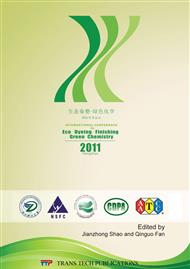p.346
p.351
p.356
p.360
p.366
p.371
p.376
p.382
p.387
Dyes & Fluorochromes as Imaging Agents in Biology and Medicine - New Opportunities for Dyestuff and Textile Chemists
Abstract:
Dyes and fluorochromes are used in biology and medicine to generate informative microscopic and macroscopic images. This means that the presence, location, biological structure, chemical content and physiological function of cells, tissues and whole creatures can be investigated. A wide range of dyes, both textile and functional, are used in this way. It is suggested that the various groups of stakeholders involved in this approach-end-users in biomedicine; synthesizers, manufacturers & vendors of dyes; and regulators and standardizers-have much to gain by becoming significantly better connected with each other. Broadly speaking, textile dyers use colorants to make socks and shirts and ties more visually attractive, which is not an objective of professional concern to biologists or clinicians. Biomedical applications of colorants are commonly aimed at obtaining information about living systems, using imaging technologies. There are also non-imaging dye applications in which they are used as drugs or analytical reagents, but these are not considered here. Note: below, “dyes” often implies fluorochromes, whilst “biomedicine” is short for biology and medicine.
Info:
Periodical:
Pages:
366-370
Citation:
Online since:
January 2012
Authors:
Price:
Сopyright:
© 2012 Trans Tech Publications Ltd. All Rights Reserved
Share:
Citation:


